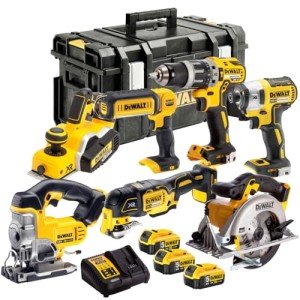
Tool Bundles
Add a review FollowOverview
-
Founded Date December 19, 1906
-
Sectors Restaurant / Food Services
-
Posted Jobs 0
-
Viewed 3
Company Description
Nine Things That Your Parent Taught You About Battery Powered Tool Set
Comprehensive Guide to Battery-Powered Tool Sets
Over the last few years, battery-powered tools have changed the method both specialists and DIY enthusiasts approach their tasks. With their convenience and efficiency, battery-powered tool sets have become a staple in workshops nationwide. This blog site post digs into the advantages of battery-powered tools, important components, contrasts, and responses to some frequently asked concerns.
Why Choose Battery-Powered Tool Sets?
Battery-powered tools offer various benefits over their corded counterparts:
-
Portability: Without the barrier of a cord, battery-powered tools can be easily carried and utilized anywhere.
-
Convenience: Quick setups get rid of the need for outlet gain access to, making them perfect for outdoor jobs.
-
Minimized Trip Hazards: The absence of cables permits a safer work space, especially in crowded or cluttered environments.
-
Technological Advancements: Most contemporary battery-powered tools include powerful lithium-ion batteries that supply longer runtimes and faster charging times.
Secret Components of a Battery-Powered Tool Set
A normal battery-powered tool set might include various tools customized to fulfill the needs of different jobs. Below is a comprehensive table showcasing requirement tools found in these sets:
| Tool | Function | Common Battery Voltage | Common Brands |
|---|---|---|---|
| Drill/Driver | For drilling holes and driving screws | 12V to 20V | DEWALT, Makita, Milwaukee |
| Circular Saw | For cutting wood, plywood, and other materials | 18V to 20V | Bosch, Ryobi, Black+Decker |
| Reciprocating Saw | For demolition and rough cuts in various materials | 18V | Porter-Cable, Hitachi |
| Impact Driver | For driving big screws/fasteners | 12V to 20V | Artisan, Ridgid |
| Sander | For smoothing surfaces and finishing wood | 12V to 20V | Ryobi, Milwaukee |
| Angle Grinder | For cutting and grinding metal, masonry, and tiles | 18V | Makita, DEWALT |
| Jigsaw | For detailed cuts in wood, plastic, and metal | 12V to 20V | Black+Decker, Bosch |
Significant Features to Consider
When choosing a battery-powered Cheap Power Tool Kits set, numerous functions can enhance usability and efficiency:
-
Battery Life: Look for tools with lithium-ion batteries that offer longer runtimes and charge quickly.
-
Interchangeability: Some Cordless Power Tool Kits sets permit battery compatibility across multiple tools, decreasing the need for several batteries.
-
Weight: Consider the ergonomics; lighter tools can lower tiredness throughout substantial use.
-
Sturdiness: Robust building and protective features (like dust and water resistance) ensure the durability of the tools.
-
Service warranty and Support: Good brands usually provide guarantees that cover defects and provide consumer support for questions.
Comparing Battery-Powered Tools to Corded Tools
The option between battery-powered and corded tools frequently comes down to individual preference and job requirements. Here’s a comparison:
| Feature | Battery-Powered Tools | Corded Tools |
|---|---|---|
| Mobility | High – can be used anywhere | Minimal – needs proximity to Power Tool Bundles outlets |
| Runtime | Limited by battery life | Continuous as long as plugged in |
| Power Tool Sets Output | Generally less effective than corded | Frequently more powerful |
| Maintenance | Needs battery care | Lower upkeep; more simple |
| Cost | Typically higher preliminary investment | More affordable for private tools |
| Versatility | Lots of multi-purpose tools offered | Specialized tools readily available |
Best Practices for Using Battery-Powered Tool Sets
To make the most out of a battery-powered tool set, follow these best practices:
-
Charge Batteries Regularly: To make sure optimum battery powered tool set life, avoid deep discharging and charge batteries after each use.

-
Tidy Tools After Use: Keeping your tools tidy decreases wear and tear and can help protect their life expectancy.
-
Store Safely: Keep tools in a dry, safe and secure area to avoid damage and guarantee easy access.
-
Check Out User Manuals: Each tool might have specific operating instructions or upkeep tips; checking out the handbook can save time and disappointment.
Often Asked Questions (FAQs)
1. How long do battery-powered tools last?
The lifespan of battery-powered tools depends on use and upkeep but can last numerous years with appropriate care. Lithium-ion batteries usually last 2-3 years, depending upon charging practices.
2. Can I utilize my battery-powered tools in cold weather?
Severe cold can impact battery performance. It’s best to keep batteries at space temperature when not in use and allow them to heat up before usage in cold conditions.
3. Are all battery-powered tools suitable with the exact same battery?
Not necessarily. Battery compatibility typically depends upon the brand name and particular tool model. It’s vital to confirm compatibility before buying extra tools.
4. How do I preserve lithium-ion batteries?
To keep lithium-ion batteries, prevent total discharges, keep them cool, and charge them after usage. It’s also recommended to use the producer’s battery charger.
5. What are the most necessary tools for a beginner?
For beginners, a drill/driver, circular saw, and effect chauffeur are typically the most necessary tools to begin with, as they cover a large range of fundamental projects.
Battery-powered tool sets have changed how we approach conventional jobs, offering a mix of convenience and efficiency. Whether for expert trades or DIY home improvements, these tools cater to diverse job needs. By comprehending the functions, elements, and best practices related to battery-powered tools, users can enhance their performance and performance. Equipped with this comprehensive guide, both newbies and seasoned professionals can now make notified choices when selecting their next tool set.



